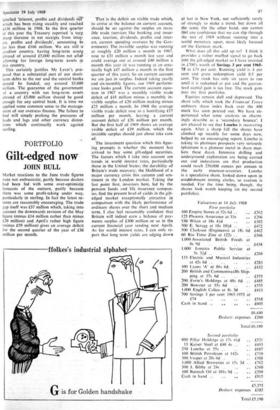PORTFOLIO
Gilt-edged now
JOHN BULL
Market reactions to the June trade figures were not enthusiastic, partly because dealers had been fed with some over-optimistic forecasts of the outturn, partly because there was some profit-taking under way, particularly in sterling. In fact the latest re- turns are reasonably encouraging. The trade gap itself was £37 million which, taking into account the downwards revision of the May figure (minus £14 million rather than minus £20 million) and April's rather high figure (minus £59 million) gives an average deficit for the second quarter of the year of £36 million per month. That is the deficit on visible trade which; to arrive at the balance on current account, should be set against the surplus on invis- ible trade (services like banking and insur- ance, tourism, dividends, profits and inter- est, current spending overseas by the Gov- ernment). The invisible surplus was running at roughly £20 million a month in 1967, rose to £31 million a month last year and could average out at around £40 million a month this year (it was running at an erra- tically high £47 million a month in the first quarter of this year). So on current account we are just in surplus. Indeed taking yearly and six-monthly figures, our 1969 perform- ance looks good. The current account equa- tion in 1967 was a monthly visible trade deficit of £45 million minus a monthly in- visible surplus of £20 million making minus £25 million a month. In 1968 the average visible trade deficit rose to a horrifying £57 million per month, leaving a current account deficit of £26 million per month. But the first half of 1969 shows an average visible deficit of £39 million, which the invisible surplus should just about take care of.
The investment question which this figur- ing prompts is whether the moment has arrived to buy some gilt-edged securities. The factors which I take into account are trends in world interest rates, particularly those in the United States; the durability of Britain's trade recovery; the likelihood of a major currency crisis this autumn and sen- timent in the London market. Taking the last point first, investors here, led by the pension funds and life insurance compan- ies, find the present level of yields in the gilt- edged market exceptionally attractive in comparison with the likely performance of ordinary shares over the short and medium term. I also feel reasonably confident that Britain will indeed earn a balance of pay- ments surplus of £300 million or so in the current financial year (ending next April). As for world interest rates, I can only re- port that long term yields are edging down
ffolkes's industrial alphabet
Gis for Golden handshake
at last in New York, not sufficiently surely or strongly to make a trend, but down all the same. On the other hand, one cannot feel any confidence that we can slip through the rest of 1969 without running into a world monetary upset, most likely focused on German mark.
What does all this add up to? I think it provides a rather muffled signal to go back infb the gilt-edged market so I have invested in £700's worth of Savings 3 per cent 1965- 75 at £74 per cent. Running yield is 4 per cent and gross redemption yield 8.5 per cent. The stock has only six years to run until it is redeemed at par and the guaran- teed capital gain is tax free. The stock goes into my first portfolio.
Equities remain dull and depressed. The short rally which took the Financial Times ordinary share index back over the 400 mark has soon petered out. We have ex- perienced what some analysts so charm- ingly describe as a 'secondary bounce'. I am pleased to see that Lonrho is recovering again. After a sharp fall the shares have climbed up steadily for some days now, helped by an encouraging report. Lonrho is taking its platinum prospects very seriously (platinum is a glamour metal in share mar- kets these days). Intensive drilling and underground exploration are being carried out and indications are that production could reach 250.000 ounces per annum in the early nineteen-seventies. Lonrho is a speculative share, looked down upon in establishment mining circles, so caution Is needed. For the time being, though, the shares look worth keeping (in my second portfolio).
Valuations at 14 July 1969 First portfolio
100 Empire Stores at 52s 6d f262 125 Phoenix Assurance at 33s .. £206 330 Witan at 18s 4fd £302 500 E. Scragg at 18s 10fd £472 500 Clarkson (Engineers) at I8s 6d £462 60 Rio Tinto Zinc at I22s £366 1,000 Associated British Foods at 8s 9d . £438 1,000 Jamaica Public Service at 5s 33d .. £266 133 Electric and Musical Industries at 42s 6d .. £283 100 Lyons 'A' at 86s 6d. £432 200 British and Commonwealth Ship- ping at 37s 6d £375 200 ,Forte's Holdings at 48s 6d. .. £485 200 Bowater at 55s 6d f555 1,000 English Calico at 8s 3d .. £413 700 Savings 3 per cent 1965-1975 at f74 £518 Cash in hand .. £605 £6,440
Deduct: expenses £260
Total £6,180
Second portfolio 600 Pillar Holdings at I7s 44d
15 Kaiser Steel at £40 4s .. 250 Lonrho at 55s 100 British Petroleum at 142s 300,Vosper at 20s 6d 1,000 Allied Breweries at I5s 3d 300 J. Bibby at 24s 100 Burmah Oil at 101s 9d .. Cash in hand ..
£5,375
Deduct: expenses £185
Total £5,190
• • • •
f521 £603 £687 £710 f3Q8 £762 £360 £509 £915


































 Previous page
Previous page